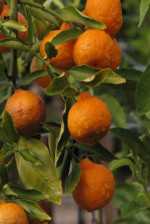Rapid Evaluation Concept For Citrus Growing Up Fast

The juvenility phase of new citrus hybrids and selections creates a frustrating bottleneck for citrus breeding programs. Breeders can generate more plant material than can be screened and evaluated. The time lag between initial planting and first flower can be substantial and can easily strain resources.
Shortening of the juvenility phase can assist greatly in the elimination of undesirable candidates and the promotion of promising selections for further evaluation. In the June 2010 edition of “Citrus Nursery Source,” readers were introduced to two experimental models intended to aid in the rapid assessment of new crosses. New Varieties Development & Management Corp. funded the construction of one system at A. H. Whitmore Farms near Leesburg (for use by the USDA breeding team) and another at UF’s Citrus Research and Education Center in Lake Alfred. The models differ in their approach, but share a common goal.
After several years of application, we can begin to assess the success of these efforts. Due to recent structural changes to the A. H. Whitmore model, this article will focus on the structure utilized by the UF/IFAS Plant Improvement Team called the Rapid Evaluation System (RES). The concept is relatively simple. Rootstock trees are planted in very tight spacing under a cable trellis system. New crosses are grafted to the rootstock, and trained in one vertical growth shoot. As the single shoot grows, all branches, thorns, and leaves are removed. Leaves remain only at the top of the tree. Rapid vertical growth is thought to speed the tree through the juvenility phase. At present time, the structure houses grapefruit hybrids, specialty fruit, and tangerine/mandarin types.
Doctor’s Exam
Recent discussions with Drs. Fred Gmitter and Jude Grosser indicate they have obtained mixed results, but feel that the effort is definitely worthwhile. Some selections have flowered very early, while others have not flowered after three years in the model. Dr. Gmitter explained that as more is learned about which parental combinations work well in the system, and which don’t, they will be able to improve efficiency and outcome.
Overall, Dr. Grosser estimates that they are seeing a two- to three-year reduction in flowering time, influenced by the genetics of the parents (some families are clearly showing a tendency to flower much earlier than others). An added benefit is that it allows the team to evaluate a large number of new hybrids in a relatively small space that is easier to maintain and easier to control psyllids. The use of systemic insecticides is more efficient and cold protection is easier to achieve than in a traditional field planting (plants with single vertical shoots can be more cold sensitive).
Fiscal Findings
There also is an economic factor to using the RES. Though the RES is labor intensive, costs are offset by other factors. Since UF/IFAS breeders are charged annually for field space, the RES approach can stretch limited financial resources. For example, the small RES structure (1 acre or less) houses 2,600 trees. If planted in the field, this would require roughly 10 acres of land and $5,000 to $10,000 per year to maintain. The RES enables evaluation of new material more quickly and in a safer and less expensive manner. Sounds like this is a concept that will be around for a while.










